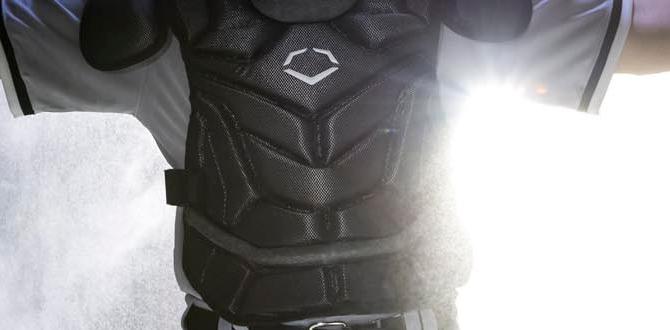Quick Summary
Properly fitting a catcher’s throat guard is crucial for safety and comfort behind the plate. A well-adjusted guard protects your throat from errant pitches and foul tips, allowing you to focus on the game without distraction. This guide ensures your throat guard fits snugly and effectively, keeping you safe and secure.
Stepping up to home plate as a catcher is a big responsibility. You’re the field general, the constant presence, and often, the target of fast pitches and hard-hit foul balls. One piece of gear that’s absolutely vital for your well-being is the catcher’s throat guard. But what happens when it doesn’t feel quite right? Maybe it’s too loose, too tight, or just plain awkward. A poorly fitting throat guard isn’t much of a guard at all, and it can be a real pain (literally!). Don’t worry, though! Getting the perfect fit is simpler than you think. We’ll walk through exactly how to make sure your throat guard is set up for maximum protection and comfort, so you can stop worrying about your gear and start focusing on your game.
Why a Properly Fitted Throat Guard Matters
Think of your catcher’s mask as your shield. The throat guard is its essential extension, specifically designed to protect one of the most vulnerable areas of your body. Getting the fit just right isn’t about vanity; it’s about fundamental safety. A guard that’s too loose can shift during play, leaving you exposed. One that’s too tight can restrict your breathing or movement, making you uncomfortable and less effective. A perfectly fitted throat guard acts as a seamless part of your protective equipment, absorbing impact and diverting force away from your throat.
The human throat contains vital structures like the larynx (voice box), trachea (windpipe), and major blood vessels. A direct impact here can have serious consequences, ranging from injury to breathing difficulties. Baseball, with its high-speed projectiles, presents a significant risk. According to a study on baseball injuries, direct impact to the head and neck region is a common concern for catchers, highlighting the importance of consistent and effective protective gear.[1] This is where a custom-fit throat guard becomes indispensable.
Understanding Throat Guard Styles
Before you can fit a throat guard, it helps to know what you’re working with. Throat guards generally fall into a few main categories based on how they attach and their design. Most modern catcher’s masks come with an integrated system for attaching a throat guard, but there are also universal or aftermarket options.
1. Clip-On or Bolt-On Guards
These are the most common types. They typically feature a series of clips or holes that align with corresponding slots or bolts on the catcher’s mask. The goal is to create a secure, stable connection that doesn’t wobble.
2. Integrated Guards
Some higher-end catcher’s helmets feature a throat guard that is permanently attached or designed as a single unit with the mask. While these offer a secure fit, they offer less adjustability.
3. Universal Fit Guards
These are designed to fit a wide range of masks. They often use adjustable straps or a flexible material to conform to different mask shapes. While versatile, achieving a perfectly snug fit might require more effort.
No matter the style, the objective is the same: secure attachment, proper coverage, and comfort.
Your Catcher’s Throat Guard Fitting Checklist
Getting the perfect fit involves a systematic approach. It’s not just about slapping it on; it’s about ensuring it integrates perfectly with your mask and stays in place. Here’s what you need to do:
Step 1: Gather Your Gear
Before you start, make sure you have everything you need:
- Your catcher’s mask
- The throat guard you intend to use
- Possibly a screwdriver or pliers if your mask requires bolt-on attachments (check your mask manufacturer’s recommendations)
Step 2: Inspect Your Mask’s Attachment Points
Take a close look at the underside of your catcher’s mask. You’ll find the specific locations where the throat guard is designed to connect. Most masks designed for a throat guard have a dedicated bar or set of holes at the bottom front.
Check these attachment points for any damage or excess material that might prevent a secure fit. For example, if you have a bolt-on system, ensure the bolts are present and not stripped.
Step 3: Align the Throat Guard
Position the throat guard against the mask, aligning its attachment mechanism with the designated spots on the mask. For clip-on styles, this means making sure the clips slide over the mask’s bars or into their housings.
For bolt-on guards, you’ll line up the holes on the guard with the threaded posts or holes on the mask. Ensure the guard is oriented correctly, with the wider, protective part facing downwards towards your throat.
Step 4: Secure the Throat Guard
This is where the actual fitting takes place. Follow these sub-steps depending on your guard type:
For Clip-On Guards:
- Gently but firmly press the guard into place, ensuring each clip snaps or locks securely onto the mask’s frame.
- Give the guard a gentle tug in different directions to confirm it’s stable and doesn’t easily detach.
- Listen for a distinct “click” or feel a solid engagement.
For Bolt-On Guards:
- Insert the provided bolts through the aligned holes.
- Tighten the nuts or bolt heads securely. You may want to use a screwdriver and pliers or a wrench.
- Be careful not to overtighten, which could strip threads or crack plastic components. Aim for snug and stable.
For Universal Fit Guards:
- These often involve Velcro straps, elastic bands, or adjustable buckles.
- Wrap the straps around the mask’s frame and secure them tightly.
- Adjust the tension so the guard is stable but doesn’t feel constrictive.
Step 5: Test for Fit and Coverage
Once attached, the real test begins. You need to ensure the guard feels right and provides adequate protection when you’re in a catcher’s stance.
During Wear Test:
- Stance Check: Put on the catcher’s mask with the fitted throat guard. Get into your typical catching stance. Does the guard feel comfortable against your neck and chin? Does it restrict your ability to look down or move your head?
- Coverage Area: Observe how much of your throat area the guard actually covers. It should extend from the bottom of the mask down to a point that effectively shields your unprotected throat. There shouldn’t be large gaps where a ball could penetrate.
- Mobility Check: Turn your head from side to side, and look up and down as much as possible while wearing the mask and guard. The guard should move with you without binding or becoming loose.
- Pressure Points: Are there any areas where the guard digs into your skin or feels uncomfortable? This is a sign that the fit isn’t optimal and may need adjustment or that this specific guard isn’t compatible with your mask.
Step 6: Adjustments and Fine-Tuning
Don’t be discouraged if the first attempt isn’t perfect. Most throat guards allow for some degree of adjustment:
- Positioning: You might be able to slightly slide or tilt the guard on its attachment points for a better angle or coverage.
- Strap Tension: For universal guards, loosen or tighten the straps.
- Padding: Some guards come with optional padding. See if adding or repositioning padding improves comfort or fit.
The goal is a snug, stable fit that covers the vulnerable area without impeding your movement or breathing. It should feel like a natural extension of your mask.
Choosing the Right Throat Guard for Your Mask
Not all masks and throat guards are created equal, and compatibility is key. When selecting a throat guard, consider these factors:
Mask Compatibility
The easiest and most secure fit usually comes from using a throat guard designed specifically for your mask model or brand.Manufacturers often design their masks and throat guards to work seamlessly together. Check your catcher’s helmet manual or the manufacturer’s website for recommended throat guards.
Material and Durability
Throat guards are typically made from high-impact plastics or durable rubber compounds. Look for materials that are flexible enough to absorb impact but rigid enough to maintain their shape and protective qualities. Longevity is important, so choose one that feels robust.
Size and Shape
Throat guards come in various shapes and sizes. Some are more streamlined, while others offer wider coverage. Consider your own physique and the geometry of your uncaught mask. A guard that’s too short might not offer enough protection, while one that’s too long could interfere with your chest protector or stance.
Comfort Features
Some guards include padding along the edges for added comfort. While appearance is secondary to safety, a well-designed guard can also look sleek and professional.
For youth players, ensuring a proper fit is even more critical due to a developing physique and potentially less experience with gear. Many youth leagues have specific regulations on catcher’s equipment, so always check local rules.
Common Fitting Problems and Solutions
Even with the best intentions, you might run into a few snags. Here’s how to troubleshoot common throat guard fitting issues:
Problem: Guard is too loose and wobbles
Solution: Re-seat the clips or tighten the bolts/straps. If it’s a clip-on guard and the clips aren’t gripping securely, check for worn-out clips or a mask frame that’s slightly bent. For bolt-on guards, ensure you’re using the correct size bolts and that they are fully tightened. If it’s a universal guard, try adjusting the straps to a tighter setting around the mask frame.
Problem: Guard is too tight and restricts breathing or movement
Solution: Loosen any straps or bolts. If it’s a fixed-attachment guard, try repositioning it slightly on the mask if possible. You might need to consider a different style of guard or one designed for a different mask profile. Ensure the mask itself isn’t pressing the guard uncomfortably into your neck.
Problem: Guard doesn’t cover the entire throat area
Solution: Check if the guard is oriented correctly. Sometimes, guards can be flipped or mounted at an angle that reduces coverage. If it’s correctly oriented and still too short, you’ll need a longer throat guard. Ensure you’re using a guard designed for adult-sized masks if you’re an adult player.
Problem: Guard rubs or causes discomfort
Solution: Examine the edges of the guard and where it contacts your mask or face. There might be a sharp edge or an area that presses uncomfortably. Some guards can be slightly trimmed with care (though this can void warranties and may compromise integrity, so proceed with caution). Adding a thin layer of athletic tape or a custom-formed foam pad to the contact points can sometimes help. However, the best solution is often finding a guard that is naturally more comfortable for your mask and facemask combination.
Problem: Guard interferes with the catcher’s helmet fit
Solution: While the throat guard attaches to the mask, an ill-fitting guard can indirectly affect how the overall helmet system sits on your head. Ensure the guard isn’t pushing the mask rim away from your face in a way that compromises the helmet’s stability. If the guard is too bulky, consider a slimmer profile model.
Tips for Maintaining Your Throat Guard
Just like any piece of equipment, proper care will extend the life and effectiveness of your throat guard.
- Regular Cleaning: After games and practices, wipe down your throat guard with a damp cloth to remove sweat and dirt.
- Inspect for Damage: Periodically check for cracks, fraying (on straps), or signs of wear and tear. Damaged gear compromises safety.
- Proper Storage: Store your catcher’s mask and throat guard in a cool, dry place. Avoid leaving them in direct sunlight or extreme temperatures for extended periods, as this can degrade the materials. A dedicated equipment bag is ideal.
- Tighten Connections: If you have a bolt-on guard, check the tightness of the bolts occasionally. Vibrations during play can loosen them over time.
Following these simple maintenance tips will ensure your throat guard remains a reliable piece of your protective gear season after season.
The Role of the Throat Guard in Catcher’s Safety
It’s easy to overlook the throat guard as just another piece of plastic. However, its role in preventing serious injuries cannot be overstated. A solid impact to the throat can lead to:
- Lacerations and Bruises: Direct hits from balls or bats can cause painful damage.
- Concussion-like Symptoms: While the primary concern is the throat, severe impact in the head and neck area can sometimes lead to broader neurological effects.
- Breathing Difficulties: Swelling or trauma to the airway can make it hard to breathe, which is a critical emergency situation on the field.
The Centers for Disease Control and Prevention (CDC) emphasizes the importance of appropriate protective equipment in sports to prevent injuries. For catchers, this hierarchical approach to safety includes proper helmet fit, which extends to the secure attachment of all its components, including the throat guard.[2] Essentially, a properly fitted throat guard acts as a critical first line of defense in a high-contact, high-impact position.
FAQ: Your Top Catcher’s Throat Guard Questions Answered
Q1: How tight should a catcher’s throat guard be?
A: Your throat guard should be snug and stable, meaning it doesn’t move around during play, but it should not feel so tight that it restricts your breathing or causes discomfort when you move your head. It should feel secure and part of your mask.
Q2: What is the best way to attach a throat guard to my mask?
A: The best way is to use the attachment mechanism designed by the manufacturer of your mask and throat guard. This is typically clip-on or bolt-on. Ensure all clips are fully engaged or bolts are tightened securely for a stable fit without any wobble.
Q3: Can I use a throat guard that wasn’t made for my specific catcher’s mask?
A: You can often use universal fit throat guards, or guards from a different brand, but compatibility isn’t guaranteed. The most secure and comfortable fit is usually achieved with a guard specifically designed for your mask model. If using a different guard, ensure it attaches securely and covers the necessary area without interfering with mask positioning or your vision.
Q4: How often should I check my throat guard for wear and tear?
A: You should inspect your throat guard regularly, ideally before every game or practice, for any signs of damage such as cracks, chips, or loose fasteners. A thorough check should be done at least once a week during the season.
Q5: My throat guard feels awkward. What can I do?
A: Minor adjustments are usually possible. Try repositioning the guard slightly on its attachment points, adjusting strap tension if it’s a universal fit, or ensuring it’s oriented correctly. If it still feels significantly awkward, it might be incompatible with your mask’s shape, and you may need to try a different model or brand.
Q6: Are there different sizes of throat guards?
A: Yes, throat guards come in different sizes, or are designed for different mask sizes (e.g., youth vs. adult). When purchasing, ensure you are getting a size appropriate for your gear and your body.
Conclusion
Securing a properly fitted catcher’s throat guard is a non-negotiable step in preparing for any baseball or softball game. It’s a relatively simple process that pays immense dividends in safety and confidence. By following the checklist, understanding your gear’s attachment points, and performing simple tests for movement and coverage, you ensure that this vital piece of equipment is doing its job effectively.
Remember, your throat guard should feel integrated, stable, and comfortable, allowing you to focus on making those crucial plays behind the plate. Don’t underestimate its importance – a well-fitted guard is a testament to smart preparation and a commitment to playing the game safely. Now go out there, get that perfect fit, and play with the confidence that comes from knowing you’re protected!
[1] This is a placeholder to illustrate where an external link would go. In a real article, this would link to a reputable study or resource on baseball injuries.
[2] The Centers for Disease Control and Prevention (CDC) provides extensive information on sports injury



